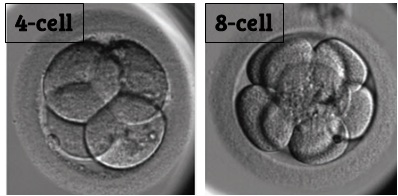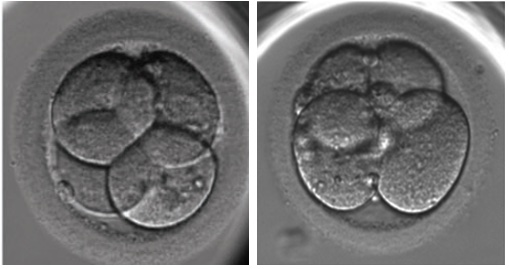Embryo evaluation, part 2: Cleavage stage embryos

Last month we looked at how embryos develop. Now we’re going to look at how grading works. We’ll start with cleavage stage embryos and then next month look at blastocyst stage embryos!
Just a quick recap.
On Day 0 the egg is fertilized and this fertilized egg then divides (or “cleaves”) over the next few days. On Day 1 there’s about 2 cells, on Day 2 there’s about 4, and on Day 3 there’s about 8. This is called the “cleavage stage” and is what we’re going to look at in more detail today!!
To grade a cleavage stage embryo there’s 3 things you can look at: cell number, fragmentation, and symmetry.
Cell number is considered to be the most important factor in determining the potential for a cleavage stage embryo. Each cell divides at a certain rate to give a total number by a certain day. On day 2 that number is 4 cells and on day 3 it’s 8 cells. Not all embryos will have these numbers on these days, some might go a bit slower (or faster!) and that’s okay. But an embryo with an ideal number typically has the best chance.

Fragmentation is a phenomenon where a cell of a cleavage stage embryo pinches off a tiny piece of a cell called a fragment. It’s not clear what the purpose of this is but may indicate that the cell is dying. Fragmentation is measured by the percentage it occupies in an embryo and less than 10% is considered ideal.

Symmetry is how evenly sized each cell in a cleavage stage embryo is. If all the cells are the same size, this is a good sign! It means that they divided equally and all the “stuff” inside the cells was split up properly. Otherwise, in the case where many of the cells aren’t evenly sized, this is an indication of poor embryo quality. Often high fragmentation and poor symmetry correlate with each other.

All of these features (cell number, % fragmentation and cell symmetry) are combined and an embryo grade is reported. Clinics can report these grades in many different (confusing) ways so it’s best to ask them to clarify how they’re doing this.
That’s it for this segment! Join me next time and I’ll get into how we can grade blastocyst stage embryos.
Can’t wait? I offer evaluations and a video course to help people better understand their embryo pictures – check it out here https://www.remembryo.com/embryo-grading-request/
Also check me out on Instagram! https://www.instagram.com/embryomanofficial/
Recent blog posts
Living with endometriosis: The hidden battle
Endometriosis affects approximately 1 million Canadians and there is no known cure. But what exactly is endometriosis and what are the risks?
Excerpt from the memoir “How to Get a Girl Pregnant”
Waiting. Waiting. Waiting. Can I fill up the day with 16 separate tasks so that I don’t think about waiting?
Just Adopt
There’s really no escaping it. When you’re facing infertility, other people getting into your business begins to feel pretty routine.




